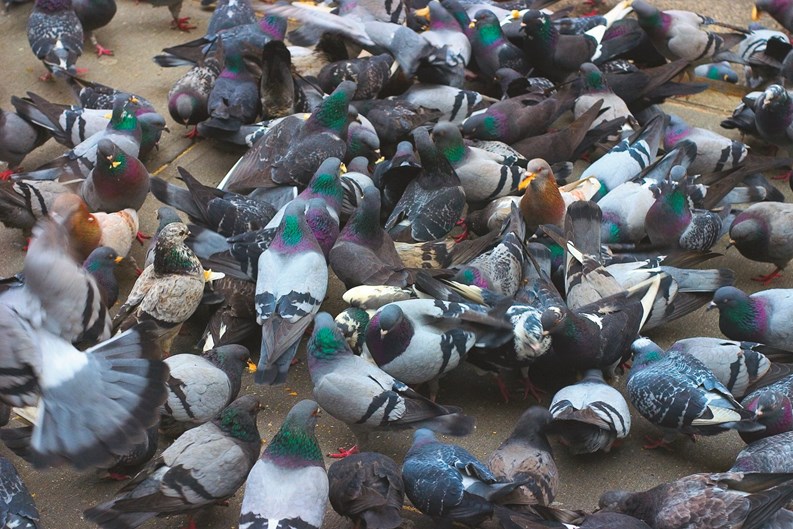If you’ve never seen an Alfred Hitchcock film and are looking for an entry point, considering adding The Birds to your Netflix queue. As an added bonus, you’ll not only be watching one of Hitch’s classics, you’ll also gain a true appreciation of ornithophobia—the fear of birds.
While hardly anyone objects to brightly-colored songbirds, hummingbirds, or regal avians such as eagles or owls, no conversation about birds is complete without mentioning perhaps the most common bird in urban settings: the pigeon. Call them “rats with wings,” call them the scavengers, call them a nuisance—if you live in Chicago, you can’t avoid them. From colorful species camped out under the El to scavenger birds making their own picnics in Grant Park, pigeons are year-round pests. And if they infiltrate your residence, they can be a serious problem.
Pigeons Past
Pigeons weren’t always city-dwellers. Joshua Engel, a research assistant in the Integrative Research Center at Chicago’s Field Museum explains, “Pigeons evolved to nest on cliffs, which helped them adapt to nesting on 'pseudo-cliffs'—places like bridges, underpasses, and buildings. The pigeons that we have in the United States are a domesticated breed of pigeon, so they are well-suited to live around people.”
And, as Vanessa A. Williams, scientific media coordinator, zoologist and animal behavior specialist at Wild Goose Chase Migratory Bird Management of Chicago Ridge, Illinois and and locations throughout the Midwest, explains, “Pigeons have been co-evolving with humans for thousands of years. They are extremely adaptable and can easily live off of our garbage and leavings. In addition to being kept captive for messenger and food purposes, feeding 'wild' pigeons is an activity that has been around for centuries. These birds have been tamed, and possibly even changed as a species, by these actions and they have learned that people provide a bountiful food source.”
“Pigeons can also breed year-round if provided proper nesting areas,” Williams continues, “and our buildings offer many nooks and crannies out of the elements where they can nest safely and comfortably. Lastly, humans have exterminated most of the natural predators in their cities that prey on pigeons, creating a wonderfully safe environment for them.”
The Blue Bird of...Disease?
While we’ve been laying down the evolutionary red carpet for pigeons, we’ve also been ushering in potential health and sanitation issues caused by excessive bird roosting. “Bird droppings and nesting material can carry 60 different transmittable diseases,” says Scott Seifert, sales director at Smithereen Pest Management Services of Niles, Illinois and Kansas City, Missouri. “Droppings are also acidic, and can eat through paint and building materials, can cause slip-and-fall accidents that can lead to personal injury and lawsuits, and droppings in excess may violate health codes resulting in fines or legal actions.”
Outside of potential embarrassing and/or painful injury, Seifert points to an aesthetic hazard. “Birds sitting on structures or the presence of bird droppings on sidewalks, stairs, and hand rails, present an unsightly and unhealthy image to visitors.”
Williams adds that “Buildup of droppings, especially near ventilation systems (pigeons seem especially fond of nesting in HVAC and air conditioning units on commercial rooftops) can lead to illness of residents…as the droppings dry, they can easily be crushed to powder, which can then be pulled into the ventilation system of buildings and sicken the people inside.”
Shoo!
If your building is suddenly besieged by feathered invaders, there are a number of steps you can take to curb these concerns before bringing in the pros. These options depend largely on the type of building and species of bird involved. “Eliminating hand feeding and keeping any food waste covered and inaccessible to the birds might solve some problems, but if nesting is involved, that is unlikely to be 100% successful,” says Williams. “Finding and repairing any holes in the building and keeping ventilation intakes netted off may help reduce nesting by smaller species of birds. We do know that the cheap options like decoys and noisemakers rarely work for more than a couple of weeks at best…the best option is tailored to each individual building for their specific issues and may involve a variety of deterrents, population growth management solutions, and structural repairs or modifications.”
Seifert adds that residents and associations should “monitor the exterior of the buildings on a regular basis looking for bird activity on ledge areas, under canopies, around roof HVAC units and vents, and making sure all vents have screens or covers. Also be vigilant about people feeding birds on the property, ensure all garbage is placed in sealed containers and that the containers are emptied prior to overflowing, and make sure that are doors, windows, and the structures are in good condition and free of damage.”
“When what you have tried to resolve the bird problem isn't effective,” Seifert says, “when the problematic bird species is protected by state or federal laws, and when the solution required exceeds your knowledge and experience, or when you want a long term solution to the problem,” it is probably time to bring in the big guns.
“Any time a bird problem is causing significant damage to structure or health and human safety, professionals should be called in to manage the issue,” says Williams. “Not only will the properties be sure they are going to be successful at resolving the wildlife conflict in question, it can help with defense against any lawsuits that may have been caused by the bird problem. On top of that, any time the birds involved are a protected native species (gulls, geese, turkey vultures, etc), professionals should be called to manage those conflicts. That process generally requires permits, special equipment and training to be sure that the birds are managed in a humane and legal way. If improper handling of these species results in injury or death to them, it can incur significant fines, and a lot of negative PR.”
Professional Intervention
Whether dealing with a protected species or a common pigeon, professional bird and pest management companies and their staff will conduct a site visit to get a sense of the nature and scope of the issue. “One of our biologists will determine the species of the bird causing the issue and the specific conflicts they are causing to the property (i.e. whether there is nesting, or they are just using the property for food and perching, the damage they have caused, etc),” says Williams. “What happens beyond that will depend significantly on what that biologist finds on the property. “
And, adds Seifert, “Return visits to the property to inspect the installed products and any bird activity should be completed every six months…and any needed maintenance on the materials will be done at this time.”
As with most solutions, they are based on the severity and specificity of the problem. Seifert explains that the right course of action for bird management can be determined by identifying the “bird species—the size and habits of the bird will determine the product that is used; also the bird pressure—how the bird is using the structure and why it is there. Bird pressure is light when birds are just sitting on open ledge areas and are not there very often. Medium pressure would be more of a roosting situation, when the birds are there overnight sitting on ledge areas that provide protection from wind and rain. Heavy pressure is when the birds are actually nesting on the property. This makes it very difficult to cause the birds to move elsewhere since they consider this area as their home.
There's also an aesthetic component to the management approach, Seifert says. “Certain products are more visible than other products. We always suggest the most effective product that will blend in with the design of the structure; installation location—the area where the product will need to be installed in will decide the product options you have. Concerns here would be how to attach the product (adhesive, screws, concrete anchors, clamps, etc...). Finally, there's budget. Sometimes the best long--term solution is not economically feasible initially. We can work with the customer to prioritize affordable portions of the solution that can be incorporated over time.”
Once you’ve got your pest identified and a funded course of action, Williams says, “We have a variety of structural deterrents that range from low-tech spike lines along perching areas, shock track, wire spiders for light poles, netting for ventilation systems and loading docks to high-tech such as solar powered Eagle Eye deterrents for gulls and chemical contraceptives for pigeons. We also offer signage to properties that have issues with people feeding the birds.”
From spikes to electrified systems; from metal vents to plastic owls, there are seemingly as many forms and styles of bird deterrents as there are bird species. Prepare to pay a sliding scale, based on factors like what kind of bird you are dealing with and the condition of the building and area involved (Seifert suggests that overall costs can range from $200 for a one-time vent clean-out and screening to up to $100,000 for bird netting installation and surface cleaning). Regardless of cost, however, Williams makes the point that “It will likely be a lot cheaper than a lawsuit and fines caused by someone sickened due to excessive bird droppings.”
For those residents who want the problem gone, but want to act humanely, both Williams and Seifert explain that most bird removal approaches are non-lethal. “The vast majority of our methods are non-lethal, and are designed to discourage or prevent the birds from choosing our clients’ properties as a nesting and roosting site,” says Williams.
So, before you throw up your hands and fly the coop (sorry, we couldn’t resist), remember that bird concerns can be met with a vast array of resolutions. From preventative action to full on bird warfare, your residents, association and board don’t have to consider birds as permanent tenants, and before you’ll know it your biggest bird anxiety will be getting christened in Grant Park or hiding under the covers during the really scary parts of The Birds.
Rebecca Fons is a freelance writer and a frequent contributor to The Chicagoland Cooperator.







Leave a Comment